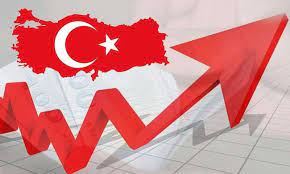Turkish GDP in the final quarter of 2022 was driven by robust private consumption, while net exports turned out to be a drag. Growth for the whole year was strong at 5.6%, despite some momentum loss in the second half.
Turkish GDP expanded 3.5% annually last quarter on a year-on-year basis – higher than expectations – on the back of private consumption, government consumption and gross fixed capital formation, while net exports were a drag. Accordingly, after a double-digit print in 2021, GDP growth last year turned out to be 5.6% year-on-year.
However, the Turkish Statistical Institute revised the third quarter GDP expansion to 4.0% from 3.9%, although the second half of the year performed relatively modestly following above 7% year-on-year growth rates in the first two quarters of 2022.
Fourth-quarter GDP translates into a quarter-on-quarter growth rate of 0.9% after seasonal adjustments, showing some momentum gain in comparison to a slightly negative reading in the third quarter, the lowest since the start of the Covid-19 pandemic. Sequential performance is attributable to 1) an acceleration in household consumption given the rapid expansion in consumer loans (including consumer credit) and negative real rates, leading to fewer savings and the bringing forward of future spending demand and 2) a turn of capital expenditures to positive after a weak investment appetite in the third quarter.
When we look at the breakdown of expenditures, private consumption has maintained its strong pace with 16.1% YoY growth and turned out to be the major driver with a +10.3ppt contribution to the headline GDP expansion. Recovery in consumer confidence in the second half with further acceleration in the fourth quarter, which is likely attributable to stability in the exchange rate, has given evidence of strength in consumption. The breakdown reveals a balanced outlook with strong support from both goods and services.
Regarding investment appetite, construction investments that have been generally negative since the 2018 financial volatility, with few exceptional quarters, turned to slight growth in the final quarter of last year, while machinery and equipment that has followed a strong path since late 2019 showed a considerable momentum loss, with 2.3% YoY growth. Whether this is a sign of a pattern change is yet to be seen in the upcoming quarters. Accordingly, fourth-quarter investment growth turned to positive at 2.6% YoY, translating into a 0.6ppt contribution to the headline reading.
Additionally, public consumption continues to positively contribute to the growth with a 9.0% YoY increase, lifting fourth quarter growth up by 1.2ppt, the highest since early 2018. This was reflected in the continuing expansion in primary expenditures, recording more than a 10% real increase in the fourth quarter over the same period of 2021. Meanwhile, inventory build-up shaved 5.6ppt off growth, while net exports pulled the headline growth rate down by -3.1ppt, the first negative contribution in the last two years. This is attributable to accelerating imports vs some momentum loss in exports with a deteriorating growth outlook in Turkey’s export markets.
In the sectoral breakdown, as signalled by the industrial production data, industry was a drag with a -0.6ppt contribution to fourth-quarter growth. Among positive drivers, services, once again, was the biggest contributor, pulling the third quarter performance up by 2.1ppt, followed by financial services at 0.5ppt.
Overall, the fourth-quarter GDP reflected strong consumption demand and government spending which were also the major drivers in recent quarters. Looking ahead, the general expectation is that the devastating earthquakes that hit the country this month will weigh on the economic output in the short-term, despite the expectation that reconstruction efforts in the form of higher public investment should generate higher growth in the longer term. Additionally, uncertainty ahead of the presidential elections and subdued European growth are other factors that can adversely impact the growth outlook.
ING
